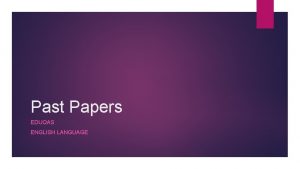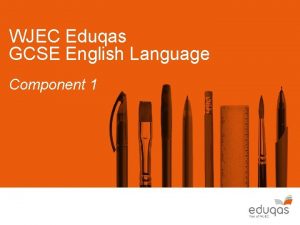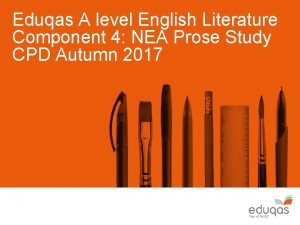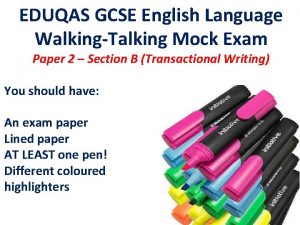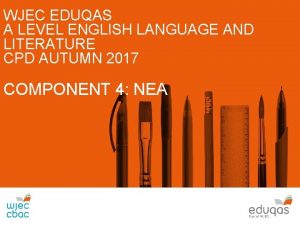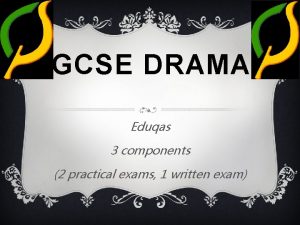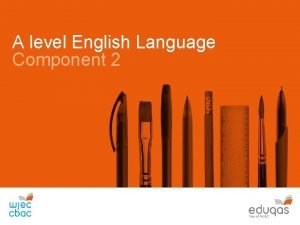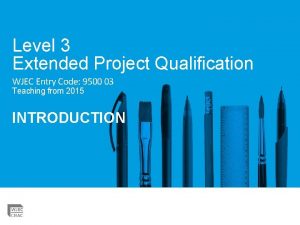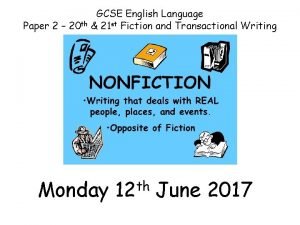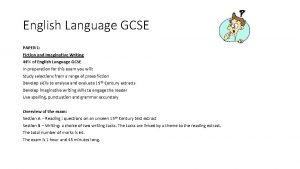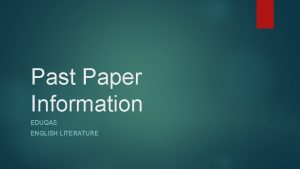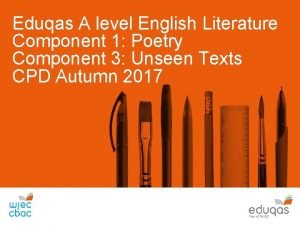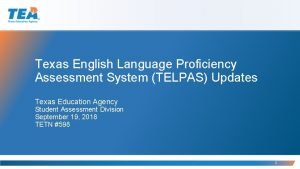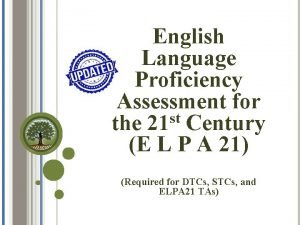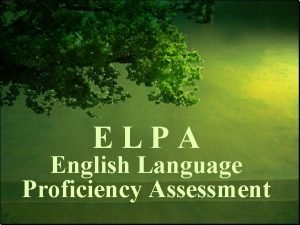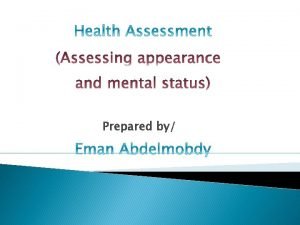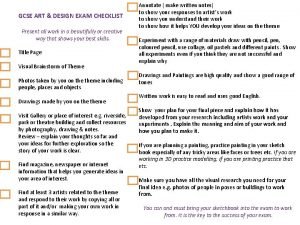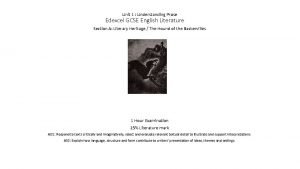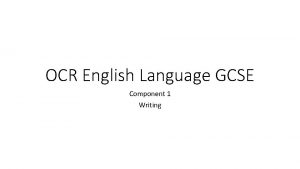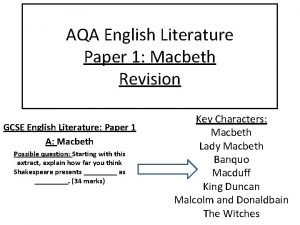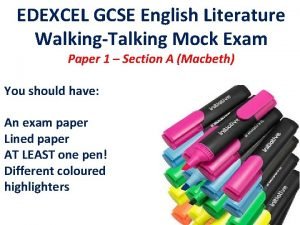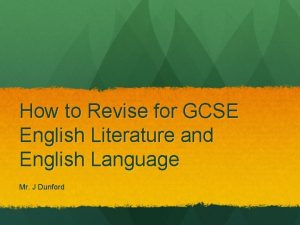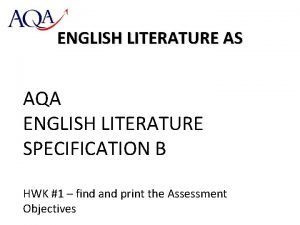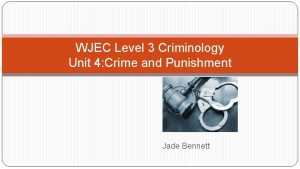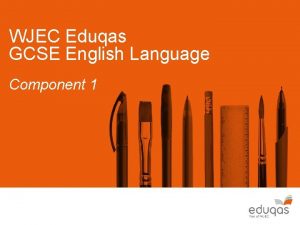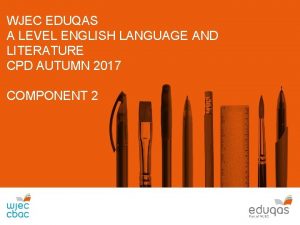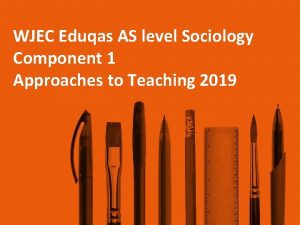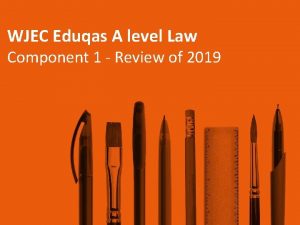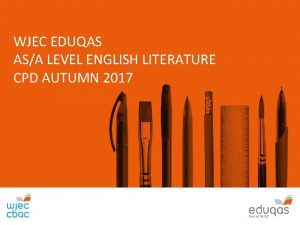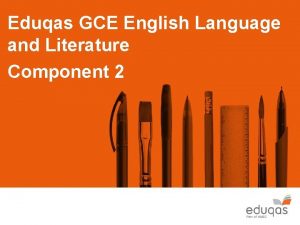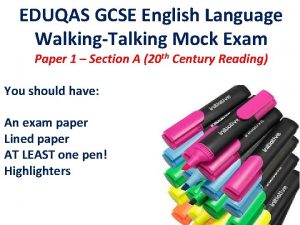WJEC Eduqas GCSE English Language Component 1 ASSESSMENT





















































- Slides: 53

WJEC Eduqas GCSE English Language Component 1

ASSESSMENT SUMMARY Specification and Sample Assessment Materials Component 1: 20 th Century Literature Reading and Creative Prose Writing Written examination: 1 hour 45 minutes 40% of qualification Section A (20%) – Reading One extract (about 60 -100 lines) of literature from the twentieth century Total marks = 40 Section B (20%) – Prose Writing One creative writing task drawn from a selection of four titles Total marks = 40

COMPONENT 1 ASSESSMENT OBJECTIVES – READING AO 1 Identify and interpret explicit and implicit information and ideas (assessed in Question 1) AO 2 Explain, comment on and analyse how writers use language and structure to achieve effects and influence readers, using relevant subject terminology to support their views (assessed in Questions 2, 3 and 4) AO 4 Evaluate texts critically and support this with appropriate textual references (assessed in Question 5) Each Reading question targets ONE assessment objective.

Component 1 Example Question Stems AO 1: Identify and interpret explicit and implicit information and ideas List five things you learn about… List five reasons… List five things […. . ] thinks/feels about… AO 2: Explain, comment on and analyse how writers use language and structure to achieve effects and influence readers, using relevant subject terminology to support their views How does the writer show…? How does the writer present…? What impressions does the writer create…? What impressions do you get of…? How does the writer make these lines tense/exciting/dramatic…?

Component 1 Example Question Stems AO 4: Evaluate texts critically and support this with appropriate textual references Statement/Viewpoint/Quote followed by: How far do you agree with this view? To what extent do you agree with this view? Evaluate… (e. g. the way a character is presented etc…) How successfully/effectively does the writer…?

WJEC Eduqas GCSE English Language Assessment in practice: Component 1

Question 0. 3

Component 1 Assessment in Practice Question 0. 3 Indicates that AO 2 is being assessed The fire and its effect is the focus of the question How does the writer show the fire spreading and becoming very serious in these lines? [10 marks] You must refer to the language used in the text to support your answer, using relevant subject terminology where appropriate. Any subject terminology used in a response should be relevant and not just ‘feature spotting’ A reminder to the candidates of the importance of selecting appropriate textual evidence to support points

Question 0. 5

Component 1 Assessment in Practice Focus of question “In the last 20 or so lines of this passage, Patricia becomes a real heroine. ” How far do you agree with this view? [10 marks] You should write about: Indicates AO 4 is being assessed Give own opinions keeping focus of question in mind • your own thoughts and feelings about how Patricia is presented here and in the passage as a whole Evaluation of authorial method • how the writer has created these thoughts and feelings. You must refer to the text to support your answer. Opinions should be supported with relevant textual evidence

Principal Examiner’s Key Messages Reading Responses When AO 2 is assessed: • read the question carefully • don’t go outside the lines indicated • remember the mark tariff per question and plan time accordingly • track through the section of text indicated • keep the focus of the question firmly in mind • support points with appropriate evidence • avoid generalisations such as the sentence is short/long

Principal Examiner’s Key Messages Reading Responses • comment on the effects of writer’s techniques e. g. in Q 0. 3 the use of personification to describe the relentless destruction caused by the fire. • how a writer achieves effects is a matter of content as well as authorial devices e. g. in Q 0. 4, the very fact that the girls were seemingly trapped and desperately trying to escape the fire adds to the excitement and drama • use of subject terminology should be ‘relevant’ and support points • be selective – quality not quantity

Principal Examiner’s Key Messages Reading Responses When AO 4 is assessed: • read the question carefully • consider the lines indicated and the passage as a whole • keep the focus of the question firmly in mind • if a statement is given, it can be agreed with, partly agreed with, or disagreed with entirely • opinions must be based on the question asked • support opinions with appropriate textual evidence • evaluate authorial method and how these methods have shaped opinions/reactions

Section B: Creative Prose Writing

COMPONENT 1 ASSESSMENT OBJECTIVES - WRITING (50% of the overall qualification) AO 5 Communicate clearly, effectively, and imaginatively, selecting and adapting tone, style and register for different forms, purposes and audiences; Organise information and ideas, using structural and grammatical features to support coherence and cohesion of texts. AO 6 Candidates must use a range of vocabulary and sentence structures for clarity, purpose and effect, with accurate spelling and punctuation. (This requirement must constitute 20% of the marks for each specification as a whole. )

COMPONENT 1: SECTION B - WRITING 24 marks are awarded for communication and organisation; 16 marks are awarded for vocabulary, sentence structure, spelling and punctuation. Choice of titles (candidates choose one): • A Memorable Weekend. • Write about a time when you had to make a difficult choice or decision. • Write a story which begins: “You are not staying here on your own. Get in the car now, ” my mum said in that voice which did not allow any argument. • Write a story which ends: I feared the worst but the teacher could not stop herself from laughing. [40 marks] © WJEC CBAC Ltd.

Principal Examiner’s Key Messages Writing Responses • the choice of titles will allow for opportunities to write from personal experience or to create imaginative fiction • five/ten minutes spent planning the narrative is time well spent • pre-prepared responses should be avoided, as should those which don’t have any link, or a very tenuous link to the choice of titles • the imaginative should not be confused with the implausible • “write what you know” is generally good advice • the narrative should be coherent - don’t lose the plot • structure-importance of paragraphs

Principal Examiner’s Key Messages Writing Responses • description within the narrative helps to develop character, scene etc. … but a pure description will be self limiting as it will lack narrative plot and drive • no novellas - keep the timeline, number of characters and number of ‘events’ manageable • avoid ‘crash landings’ • practise writing stories in short time periods • time should be allocated to check technical accuracy, especially commas, full stops, tenses and speech punctuation

WJEC Eduqas GCSE English Language Component 2

ASSESSMENT SUMMARY Component 2: 19 th and 21 st Century Non-Fiction Reading and Transactional/Persuasive Writing Written examination: 2 hours 60% of qualification Section A (30%) – Reading Two extracts (about 900 -1200 words in total) of high-quality non-fiction writing from the nineteenth and twenty-first centuries Total marks = 40 Section B (30%) – Writing Two compulsory transactional/persuasive writing tasks Total marks = 40

COMPONENT 2 ASSESSMENT OBJECTIVES – READING AO 1 • Identify and interpret explicit and implicit information and ideas (assessed in Question 1 and 3) • Select and synthesise evidence from different texts (assessed in Question 5) AO 2 Explain, comment on and analyse how writers use language and structure to achieve effects and influence readers, using relevant subject terminology to support their views (assessed in Question 2 ) AO 3 Compare writers' ideas and perspectives, as well as how these are conveyed, across two or more texts (assessed in Question 6) AO 4 Evaluate texts critically and support this with appropriate textual references (assessed in Question 5) Each Reading question targets ONE assessment objective.

Component 2 Example Question Stems AO 1: Identify and interpret explicit and implicit information and ideas Give one example… List … How many… Give two details… What is meant by… AO 1: Select and synthesise evidence from different texts According to both writers… Using information from both texts…

Component 2 Example Question Stems AO 2: Explain, comment on and analyse how writers use language and structure to achieve effects and influence readers, using relevant subject terminology to support their views How does the writer of the article/letter/report etc…show…? How does the writer present…? How does the writer try to show … AO 3: Compare writers' ideas and perspectives, as well as how these are conveyed, across two or more texts Compare: What the writers say about… How the writers get across… The writers’ attitudes towards/views on…

Component 2 Example Question Stems AO 4: Evaluate texts critically and support this with appropriate textual references Statement/Viewpoint/Quote followed by: How far do you agree with this view? To what extent do you agree with this view? How successfully/effectively does the writer…? What do you think and feel about…?

Question 1. 2

Component 2 Assessment in Practice Question 1. 2 Indicates AO 2 is being assessed How does Mark Binelli's article try to show that prisoners in Florence live in extremely 'harsh conditions'? Focus of question You should comment on: • what he says • his use of language, tone and structure Bullet points remind candidates that they need to consider what is said as well as ‘how’ [10]

Question 1. 4

Component 2 Assessment in Practice Question 1. 4 Indicates that AO 4 is being assessed and that personal response and critical evaluation is required Focus of the question What do you think and feel about Dickens' views about solitary confinement as a punishment and the way he expresses these views? You should comment on: • what he says • how he says it How are views made clear to the reader and how do these views shape reader response [10]

Question 1. 6

Component 2 Assessment in Practice Question 1. 6 Final reading question will always assess AO 3 Both of these texts are about solitary confinement in prisons. Focus of question Compare: • what the writers say about the effects of solitary confinement on prisoners Candidates need to compare content and authorial method • how the writers get across the effects of solitary confinement in prisons You must use the text to support your comments and make it clear which text you are referring to. [10] Reminder of the importance of linking points to correct text

Component 2 Reading: Principal Examiner’s Key Messages General points: • read the instructions at the start of each question carefully to avoid answering on the wrong text! • don’t lose easy marks in Q 1. 1 by not reading the question properly • remember the mark tariff per question and plan time accordingly e. g. synthesis question is worth 4 marks and should be dealt with fairly quickly • keep the focus of the question firmly in mind • support points with appropriate evidence • consider the effects of authorial method, language and structure in Q 1. 2 and use relevant terminology

Component 2 Reading Principal Examiner’s Key Messages When AO 4 is assessed: • track text carefully • give opinions based on the question asked and the specific focus given • show understanding of the writer’s views • support opinions with appropriate textual evidence • evaluate authorial method and how these methods have shaped opinions/reactions

Principal Examiner’s Key Messages Reading Responses When AO 3 is assessed: • identify the focus of the question and only make points linked to it • support points with appropriate textual evidence • always make it clear which text you are referring to • remember that the instruction is to compare – consider both texts • comment on content and authorial method for higher bands • connectives can be useful to help shape the response but key is to make points clear and relevant

Section B: Transactional/Persuasive Writing

COMPONENT 2 ASSESSMENT OBJECTIVES - WRITING (50% of the overall qualification) AO 5 Communicate clearly, effectively, and imaginatively, selecting and adapting tone, style and register for different forms, purposes and audiences; Organise information and ideas, using structural and grammatical features to support coherence and cohesion of texts. AO 6 Candidates must use a range of vocabulary and sentence structures for clarity, purpose and effect, with accurate spelling and punctuation. (This requirement must constitute 20% of the marks for each specification as a whole. )

COMPONENT 2: SECTION B - WRITING • two compulsory questions • for each question, 12 marks are awarded for communication and organisation; 8 marks are awarded for vocabulary, sentence structure, spelling and punctuation • audience, purpose and format will be made clear in the question

Question 2. 2

Component 2 Assessment in Practice Question 2. 2 This is part of a letter that appeared in a newspaper: 'I can't understand why we have pets. They can be expensive to look after, they take up lots of time, children want them then get bored of them, yet if you dare to say you would never have a pet, people think you are strange. I would never have one. ' Write a letter to the newspaper giving your views on this subject. [20]

Principal Examiner’s Key Messages Writing Responses • • • split time equally between the two tasks aim for 300 -400 words per task address the audience and purpose given in the task adopt an appropriate tone for the task practise writing in different formats e. g. letter (formal and informal), articles, reports, talks etc… format letters appropriately and include a suitable greeting and sign off spend time checking basic punctuation take time to plan and structure responses depth and detail will help to develop convincing responses

WJEC Eduqas GCSE English Language Component 3 Non-exam assessment

ASSESSMENT SUMMARY Component 3: Spoken Language (Can be carried forward) Non-exam assessment Unweighted One formal presentation/speech, including responses to questions and feedback. Spoken language will be reported on as part of the qualification, but it will not form part of the final mark and grade.

Assessment Objectives SPOKEN LANGUAGE (Unweighted) AO 7 Demonstrate presentation skills in a formal setting AO 8 Listen and respond appropriately to spoken language, including to questions and feedback to presentations AO 9 Use spoken Standard English effectively in speeches and presentations.

Component 3 Spoken Language: Key Messages Main issues arising from the first monitoring process: • Key importance of task setting • Need to develop effective assessment procedures • How to prepare monitoring sample efficiently • Value of reflecting on and reviewing departmental approaches using best practice as guide

Component 3 Spoken Language: Key Messages Task Setting: Less Successful Approaches Imposing the same task on all candidates Using presentation solely as English literature revision exercise Poorly planned paired or group presentations Reading aloud written speech, especially from Ppt slides Allowing a totally free choice of topic without guidance Under-playing importance of question and answer section Lack of flexibility in composition of audience

Component 3 Spoken Language: Key Messages Task Setting: Best Practice ü Adopting a flexible approach – ‘horses for courses’ ü Allowing candidates some autonomy in choosing topic ü Giving clear guidance on subject matter, effective approaches and presentation skills ü Guiding candidates aiming at Merit or Distinction towards challenging or sophisticated material ü Emphasising importance and benefits of Q and A component ü Using knowledge gained from legacy Speaking and Listening ü Encouraging a positive attitude to Spoken Language as a key life skill

Component 3 Spoken Language: Key Messages Task Setting: some successful approaches • Tapping into candidate’s genuine interests and expertise • Using some of Interboard standardising presentations as examples of what, and what not, to do • Tweaking tasks to avoid ‘show-and-tell’ approach by including clear purpose • Discussing what makes an effective question • Advising on use of notes and/or Power. Point slides • Reinforcing value of presentation skills and SL overlap with exam preparation, especially Component 2

Component 3 Spoken Language: Key Messages Task Setting: some examples of successful tasks ü Teaching a topic: • set poem or skill to rest of class • how to use social media to OAPs ü Characters on trial • presenting defence of Scrooge or Iago • delivering prosecution case against Othello or Henry V ü Competitive ‘Balloon game’ approach: • Promoting a burning issue to be chosen as a Private Member’s bill • Proposing a charity/cause for key donation • Defending a favourite band or programme, game or sport, celebrity (alive or dead) threatened with ‘extinction’ • ‘Room 101’ format but with single proposal and scope for challenge and sophistication

Component 3 Spoken Language: Key Messages Task Setting: Tweaking or Reshaping Show-and-Tell • My hobby • My holiday • My Work Experience • Kim Kardashian • Game of Thrones Purposeful Presentation • Persuading audience to adopt hobby • Promoting holiday destination to tour company • Advising Year 10 on surviving work experience or defending or condemning the WE scheme to a Parliamentary Select Committee

Component 3 Spoken Language: Key Messages Assessment Issues Higher grades were sometimes awarded even when all the criteria for Merit and Distinction had not been met: • challenging or sophisticated content • evidence of range of vocabulary and repertoire of strategies to meet needs of audience and engage their interest • fulfilling the purpose of the presentation – there was often no clearly defined outcome to address • detailed, appropriate and perceptive responses to questions

Component 3 Spoken Language: Key Messages Accurate Assessment: Best Practice ü Consider assigning responsibility as co-ordinator for SL to one member of department ü Ensure all teachers involved have discussed Interboard standardising materials and are confident in using competency model ü Plan ahead to decide best timing/approach for each class: Year 10 or 11; staggered or all at once; type of audience; how many to record, etc. ü Consider recording a range from each class to facilitate efficient internal standardisation and preparation of monitoring sample

Component 3 Spoken Language: Key Messages Where we are now Drawbacks Benefits No written coursework Time factor Skills overlap Unweighted statu Candidate reticen s Valuable life skill ce Confidence boost

Further Guidance Further information on the assessment of Spoken Language can be found on our WJEC Eduqas website: Standardised exemplars and commentaries are available on our secure website. Alternatively, any queries can be directed to: gcseenglish@eduqas. co. uk.

ANY QUESTIONS? Contact our specialist subject officers and support team: Nancy Hutt Subject Officer, GCSE English Language 029 2026 5023 Matt Oatley Subject Support Officer, GCSE English Language 029 2026 5054 gcseenglish@eduqas. co. uk
 English language a level eduqas
English language a level eduqas Eduqas gcse english language past papers
Eduqas gcse english language past papers Wjec english literature specification
Wjec english literature specification Eduqas english language component 1
Eduqas english language component 1 Eduqas english literature past papers a level
Eduqas english literature past papers a level Nea english literature a level ideas
Nea english literature a level ideas Eduqas gcse english language past papers
Eduqas gcse english language past papers Eduqas product design a level
Eduqas product design a level Eduqas a level film
Eduqas a level film Wjec gce english language and literature
Wjec gce english language and literature Eduqas english literature a level
Eduqas english literature a level Gcse computer science wjec
Gcse computer science wjec Gcse electronics
Gcse electronics Wjec gcse ict
Wjec gcse ict Wjec media studies gcse
Wjec media studies gcse Drama eduqas gcse
Drama eduqas gcse Gcse media studies eduqas
Gcse media studies eduqas Eduqas religious studies route a past papers
Eduqas religious studies route a past papers English language component 2
English language component 2 English literature wjec
English literature wjec Wjec english literature a level
Wjec english literature a level Eduqas esubmission
Eduqas esubmission Edexcel gcse english language comparison question
Edexcel gcse english language comparison question Edexcel gcse english language paper 2
Edexcel gcse english language paper 2 Unseen poetry past papers edexcel
Unseen poetry past papers edexcel Language
Language Is english language paper 1 fiction or nonfiction
Is english language paper 1 fiction or nonfiction Eduqas english literature past papers
Eduqas english literature past papers Yesterday poem by patricia pogson analysis
Yesterday poem by patricia pogson analysis Yesterday by patricia pogson analysis
Yesterday by patricia pogson analysis Eduqas a level english literature
Eduqas a level english literature Telpas alt rubric
Telpas alt rubric English language proficiency assessment (elpa)
English language proficiency assessment (elpa) Elpa test
Elpa test Component of health assessment
Component of health assessment Gcse art assessment objectives edexcel
Gcse art assessment objectives edexcel Gcse art annotation format
Gcse art annotation format Ocr gcse pe nea
Ocr gcse pe nea Levels of language knowledge
Levels of language knowledge Edexcel gcse english literature
Edexcel gcse english literature Language book
Language book Literature paper 1 macbeth
Literature paper 1 macbeth Macbeth edexcel questions
Macbeth edexcel questions How to revise for english literature
How to revise for english literature Central bedfordshire assessment centre training
Central bedfordshire assessment centre training Pearson unseen material
Pearson unseen material Aqa english literature specification
Aqa english literature specification An inspector calls exam questions edexcel
An inspector calls exam questions edexcel Explain factors to consider when proposing dishes for menus
Explain factors to consider when proposing dishes for menus Wjec criminology unit 4 grade boundaries
Wjec criminology unit 4 grade boundaries Criminology unit 4
Criminology unit 4 Rmxjokhf_aa -site:youtube.com
Rmxjokhf_aa -site:youtube.com Wjec hospitality and catering
Wjec hospitality and catering Wjec appointees
Wjec appointees

